The Best Core Exercises For All Fitness Levels
These beginner, intermediate and advanced core exercises will help you to develop a stronger core

The Police’s 1983 classic “Every Breath You Take” is not about your core muscles, but it could be – because every breath you take, every move you make, every step you take involves using your core.
Doing core exercises to ensure your core is strong and flexible will help you in the gym, playing sports or just going about your daily business. A strong core will also help you maintain good posture and avoid issues like lower-back pain.
Basically, core exercises are a must for any fitness routine, so we asked Richard Tidmarsh, strength and conditioning coach and founder of Reach Fitness, for the moves he recommends for beginner, intermediate and advanced gym-goers.
Of course, not everyone has access to a gym, so we’ve also listed our favourite core exercises for home so no-one misses out on the benefits of core training. But first, some answers to frequently asked questions.
Core Exercises FAQ
What muscles make up the core?
“Your core consists of multiple muscles,” says Jess King, trainer at F45 Mill Hill. “These include your transverse abdominis, rectus abdominis, internal and external obliques, diaphragm, pelvic floor, erector spinae and your multifidus.”
How often should you do dedicated core exercises?
“I would recommend doing core exercises two to three times per week at the end of a training session,” says King. “Doing five to 10 minutes of core training with two or three exercises is a great way to finish a workout!”
What do people tend to get wrong with core training?
“The things I see people get wrong are arching the back and straining the neck,” King says. “When doing core exercises lying on your back, you want to always keep your lower back pushing down towards the floor as much as possible. Sometimes this isn’t possible, depending on the shape of your spine, but you should always be aiming for that, and certainly not actively lifting your lower back off the floor.”
Beginner Core Exercises
“Building a strong core is all about keeping still, not doing hundreds of abdominal curl repetitions,” says Tidmarsh. “These three holds will create the foundation of a strong core, teaching you to keep your hips aligned and how to control your posture.”
Naturally you can do each of the exercises as part of a training session, but for a beginner core workout follow the suggested reps and rest periods below, doing five rounds in total of these three exercises.
Plank
Time 30sec Rest 0sec
Get the Coach Newsletter
Sign up for workout ideas, training advice, reviews of the latest gear and more.
The definitive core exercise. The plank involves minimal movement but maximal effort, requiring you to support your body on your forearms and toes while holding your body in a straight line from your shoulders to your ankles. You can make it easier by resting on your knees, or harder by extending your arms so you’re supported by your hands.
Dead bug
Reps 10 Rest 0sec
Lie on your back with your arms extended straight up towards the ceiling, and your legs raised with your knees bent at 90°. Lower your right arm and left leg at the same time until they are hovering just above the floor, then return to the starting position. Then do the same with the opposite limbs.
Boat
Time 30sec Rest 1min
Sit on the floor with your knees bent. Lean back slightly, keeping your back straight, and hold your arms out in front of you as you raise your feet off the ground with your legs together. If you can, extend your legs so they are straight and your body forms a V shape. You can also raise your arms and spread your legs to make the hold harder.
Intermediate Core Exercises
“Here we start to add movement to a controlled core,” says Tidmarsh. “Can you stay still with good posture whilst another area of your body moves? It's much tougher than you think!”
If you want to combine three movements in one workout, Tidmarsh has again suggested reps and rest periods. Do three rounds in total of the three exercises.
Ball push-away
Reps 8 Rest 0sec
Get into a plank position with your feet spread and your forearms resting on a gym ball. Push the ball away with your forearms, then pull it back it, while maintaining the plank position.
Hanging knee raise
Reps 8 Rest 0sec
On a set of dip bars, hold yourself steady with arms fully extended. Raise your knees towards your chest, then lower them slowly. Repeat. You can also do this exercise hanging from a pull-up bar.
Dumbbell plank drag
Reps 8 Rest 1min
Get into the top press-up position. Put a dumbbell on the ground just to the right of your torso. Reach underneath and across with your left hand to grab the dumbbell and drag it to your left side. Then mirror the movement with your right hand.
Advanced Core Exercises
“Now we start to add greater difficulty to posture control by adding more of a load, more of your bodyweight, or a larger range of movements,” says Tidmarsh. “Remember – slow and steady movement wins the race to a stronger core.”
Put these three core exercises together for this quick but brutal core workout designed by Tidmarsh. Do three rounds in total.
Strict toes to bar
Reps 6 Rest 0min
We did say these were advanced exercises, and this is certainly not one for newbies. While hanging from a pull-up bar, bend at the hips (not the waist) and lift your toes to the bar, keeping your legs together as you move.
L-sit
Time 30sec Rest 0sec
Use a pair of parallettes for this core cruncher. Lift and hold yourself up above the parallettes with your arms extended. Extend your legs straight out in front of you so you form an L-shape. Hold it – if you can.
Wall plank
Time 30sec Rest 1min
Another savage hold exercise. Get into an elevated plank with your feet against a wall so you form a flat, horizontal line from heels to head. Hold. HOLD!
Core Exercises For Home
Given how important a strong core is, it’s well worth continuing your core training away from the gym. And just because many of the more advanced moves Tidmarsh suggests require weights or other equipment, that doesn’t mean you can’t challenge yourself using just your own bodyweight. Here are plenty more exercises to master, which either require no equipment or affordable bits of kit like resistance bands.
Hand walk-out
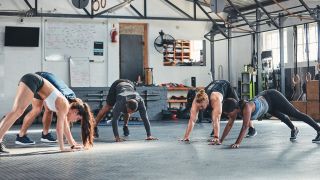
The equipment-free version of Tidmarsh’s gym ball push-away or the abs roll-out is a great way to build up to those challenging moves. From standing, fold forwards at your hips and place your hands on the floor. Walk your hands out one at a time until you’re in a high plank position, then keep going a little further before reversing the move to standing. The further you walk your hands from your feet the harder your core has to work to keep you upright.
Side plank

While the plank works most of the crucial core muscles, there are a few it misses. Fortunately, a minor tweak remedies that. The side plank works your obliques and the little-known quadratus lumborum, which is part of the posterior abdominal wall and a key muscle when it comes to avoiding lower back pain.
To do the side plank lie on your right side with your feet together, left stacked on top of the right, and prop yourself up on your right forearm. Push your hips up so you form a straight line from your feet to your head, then hold this position for the set time, without letting your hips drop. Make sure to repeat on the other side.
Star side plank
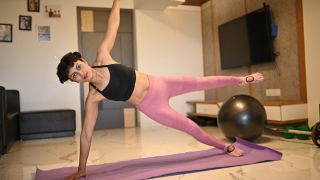
Once you are comfortable with the standard side plank this challenging variation is worth trying. Start in the regular side plank position, with your upper body supported on your forearm and one foot stacked on top of the other. Then put your bottom hand on the floor and push up to extend your arm and lift your upper body further from the floor. From this position, lift your upper limbs so your top hand points towards the ceiling and your top leg is raised and stretched – your body will be in a star shape with your head as the fifth point (kind of). Hold this position for time, then swap and do the same on the other side.
If you’re finding the star position too hard to hold, you can lower your top limbs during the time to make it a little easier, or even drop back onto your forearm. Just make sure you keep your hips up, because if you’re finding that impossible then it’s best to revert to the standard side plank to build more strength.
Leg raise

The perfect counterpart to the sit-up, which tends to work only the upper abs. Leg raises hit the lower abs hard, as well as improving the flexibility of your hips and lower back. Lie flat on your back with your legs together. Keeping them together and as straight as possible, raise them until your toes are pointing at the ceiling. Lower slowly back to the start.
Flutter kicks

A very simple exercise that starts feeling like absolutely murder after about ten seconds and only gets worse from there. Lie on your back and lift your legs slightly off the floor. Your shoulders should also be raised slightly so there is tension in your abs. Press your lower back into the floor and don’t let it lift off the floor. Then flutter your feet up and down while keeping your torso still. Keep going as long as you can, but don’t be surprised if that’s not very long.
Pallof press
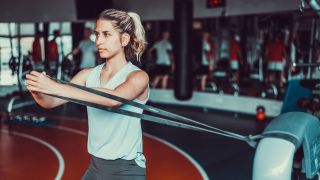
You’ll need a cable machine or a resistance band for this anti-rotation exercise, which is great for developing a stable core. Anchor your band at shoulder height or set up the cable machine with a standard handle at the same height. Stand side-on the anchor and hold the band in both hands in front of you. Step away from the anchor so the band is taut, then hold it straight out in front of you for 10 seconds, resisting the pull towards the anchor.
Bird-dog
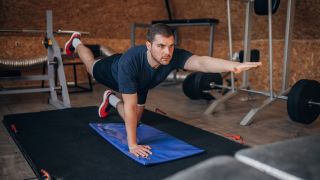
This simple core exercise improves your balance and co-ordination as well as your core strength. Start on your hands and knees, with your hands directly under your shoulders and knees under your hips. Simultaneously raise your right arm and left leg and fully extend them in front and behind you. Bring them back and repeat with the other limbs. Make sure you keep your torso still as you perform the move – your core will be working hard to keep you balanced.
Reverse crunch
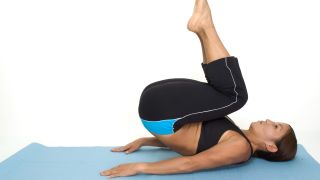
The reverse crunch is one of those rare occasions where the variation of an exercise is probably the version you should start with, since it’s both more effective than the classic crunch and less likely to hurt your neck. Lie on the floor with your legs raised and your knees bent at a 90° angle so your thighs are perpendicular to the floor. Engage your abs to bring your knees towards your chest and lift your hips off the floor. Hold this position for a beat, then slowly lower back to the starting position.
Hollow body hold
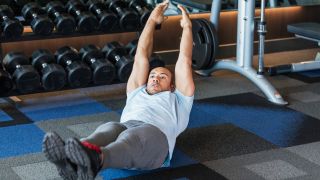
If you think that time passes slowly when holding a plank position, you won’t believe how slow it can go when you’re attempting the hollow body hold. It’s an effective way of targeting the deep core muscles as well as your abs, and the movement also benefits the quads, lats and glutes. That’s a long list of muscles that will benefit, so try to remember all of them while in position – having something to think about might make that time pass slightly quicker. Lie on your back with your legs together and your arms extended behind your head. Raise your shoulders and legs about 15cm off the floor to form a boat shape, pressing your lower back into the floor. Hold, but don’t push past the point when your form falters. If you can’t keep your lower back pressed into the floor, stop.
Aleknas
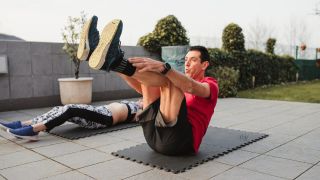
This challenging move is a step up from the dead bug, but one removed from the V-sit – the perfect stepping stone, if you will. Lie on your back with your arms extended and pointing up, and your knees in tabletop position, with a 90° bend at your hips and knees. Slowly lower your arms towards the floor, and extend your legs while lowering them, until all your limbs are just off the floor. Reverse the move in a controlled motion.
V-sit
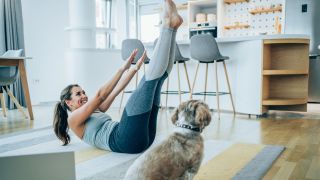
This challenging exercise hits both your upper and lower abs at the same time, making it an efficient option for those aiming to develop definition in their midsection. Lie on the ground with your legs together and your arms extended behind you. Raise your legs as high as you can, keeping them together, and lift your chest to meet them with your arms above your head to form a V-shape. If you’re struggling to keep your legs straight and can’t raise them all that high, you can bend at the knees for a modified V-sit.

Nick Harris-Fry is a journalist who has been covering health and fitness since 2015. Nick is an avid runner, covering 70-110km a week, which gives him ample opportunity to test a wide range of running shoes and running gear. He is also the chief tester for fitness trackers and running watches, treadmills and exercise bikes, and workout headphones.
